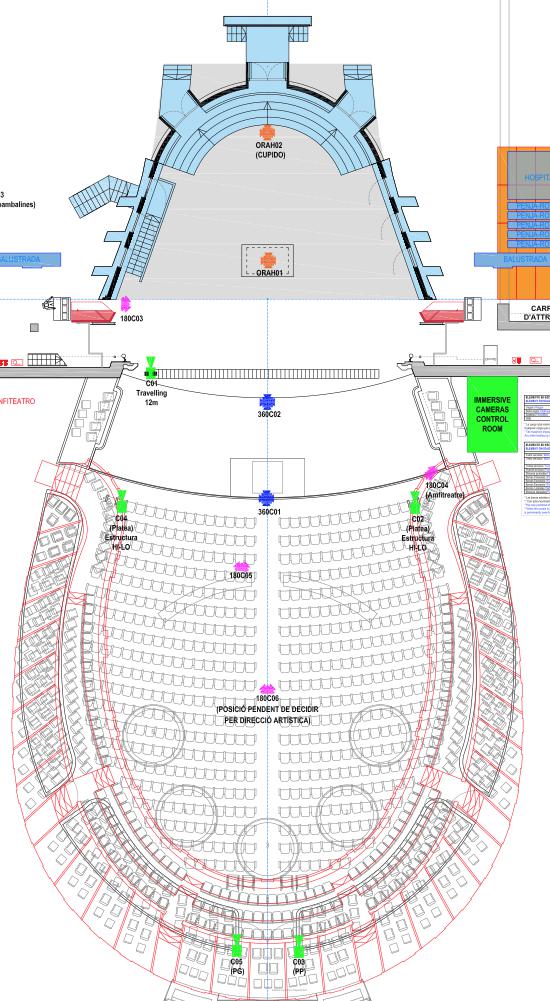The Immersive Accessibility Project (ImAc) aims to design tools that will assist with the integration of accessibility features into immersive environments. Four of the nine ImAc partners are based in Barcelona and collaborate with Liceu Opera House on a regular basis. Given the comprehensive social policy embraced at Liceu and the many accessibility services regularly made available to its visitors, we asked them to allow ImAc to record and test our tools on an opera production.
Permission was granted. CCMA, with the collaboration of the UAB, i2Cat, and the Liceu audiovisual department put together a production team.
The opera was recorded on February 10th, during the general essay Gounod’s opera and now the objective is to create an interactive product that allows the viewer to consume opera in a multiscreen format. The viewer will be able to see a traditional opera video production in a web browser in a main screen (PC or smart TV) while tablet and HMDs (Head Mounted Displays) will be used to choose between the classic television production and alternative views in 360º and 180º. All contents will be synchronized across screens which will mean that one single user or group of users, in a home environment, can watch in parallel the same content from different points of view.
Furthermore, opera being one of the most demanding scenarios when it comes to audio quality, more than 80 different audio tracks were recorded, which will now allow the audio production crew to provide detailed sound landscapes given a certain user’s (camera) position, so viewers can have also an independent immersive audio experience depending on the chosen camera and alternate this sound experience with a regular sound experience.
In addition to that, accessibility services will be explored and evaluated: subtitles, sign language and audio descriptions will be added in a way that are coherent to the active point of view (in other words, the same subtitle/sign language video insert or audio description will appear in specific places of the scene that, depending on the user’s point of view, will be presented differently in each device).
This pilot activity will be used to test already defined accessibility requirements for subtitling and audio description in immersive environments, and a number of focus groups and validation activities will be run in order to elicit the perception of these new services by different communities being addressed such as persons with disabilities, and those who use subtitles when attending opera performances.
Before the recording, an intense preparation work was carried out to define the technological intervention and obtain an interesting recording highlighting the technological challenges, from the recording of image and sound to the realization of the omnidirectional video in recordings of live shows.

The picture shows the Liceu distribution where different cameras will be placed. These are marked in green, blue, orange and pink.
![]() Directive cameras
Directive cameras
SonyFS7 (4.5Kg – 156 x 239 x 247 mm) with HI-Lo or traveling tripod.
![]() Immersive cameras 360º
Immersive cameras 360º
Studio One (<2Kg – 86 x 86 x 112 mm)
![]() Immersive cameras 180º (real 170º)
Immersive cameras 180º (real 170º)
Atudio One (<2Kg – 86 x 86 x 112 mm)
![]() Camera ORAH
Camera ORAH
Studio One (0.5 Kg – 80 x 70 x 65 mm)
Roméo et Juliette
Shakespeare’s work “Romeo and Juliet” is the most famous love story in literature and Charles Gounod, one of the great representatives of the French lyrical drama, turned it into an opera very faithful to the original tragedy. The opera “Roméo et Juliette” returns to the stage at the Gran Teatre del Liceu after 32 years, and it is conducted by Josep Pons, co-starring Saimir Pirgu and Aida Garifullina, and in co-production with The Santa Fe Opera. Stephen Lawless production places the original action in the context of the US Civil War (1861-1865). Lovers live in a classic deadly frame, as a prefiguration that will fatally condition their destiny from the beginning of their love.
By Pilar Orero



